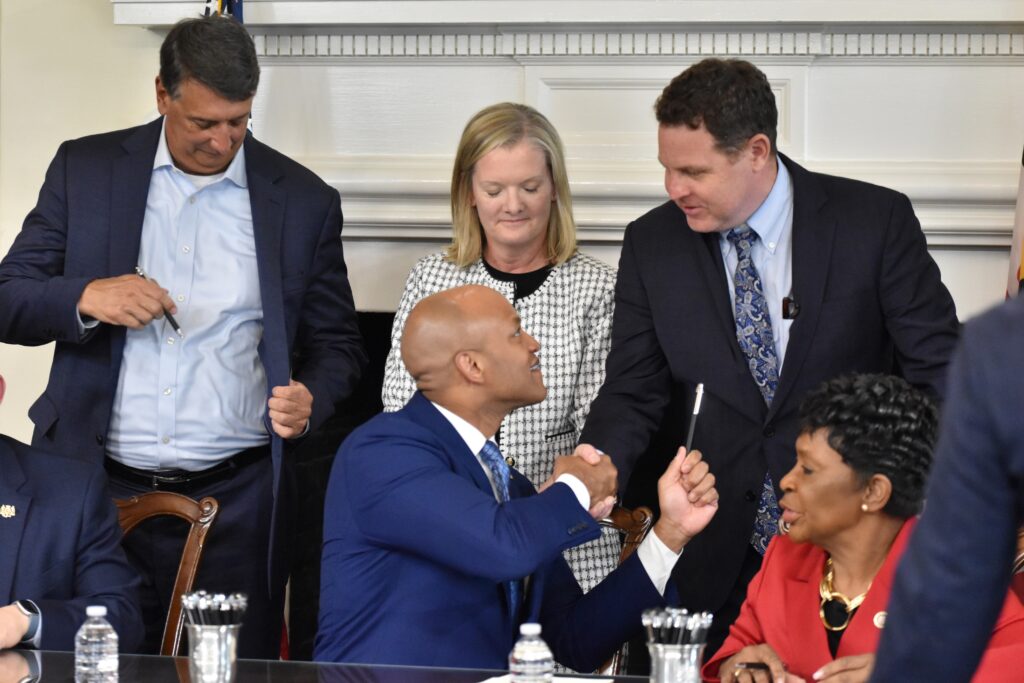Gov. Wes Moore hands a pen he used to sign the state’s $67 billion budget for fiscal 2026 to House Appropriations Chair Ben Barnes. (Photo by Bryan P. Sears/Maryland Matters)
Maryland’s $67 billion spending plan, which includes more than $1.6 billion in taxes and fees, was signed into law Tuesday by Gov. Wes Moore (D), capping what he called a session of challenges and chaos.
The signing ceremony, the fourth and final scheduled event, caps a difficult 90-day legislative session. The budget package — three bills — were part of a tranche of 181 bills signed into law Tuesday by Moore.
In opening remarks, Moore said his third legislative session “wasn’t just … a legislative season of challenge, it was also a season of change, where the obstacles that we’re up against did not change from month to month or from week to week. We all saw they were changing from day to day.”
Lawmakers entered the session needing to resolve an immediate $3.3 billion structural budget deficit projected for fiscal 2026. A similar sized gap was projected for the following year. By fiscal 2030, that gap was projected to widen to more than $6 billion.
The effort was complicated when President Donald Trump was sworn in for his second term on Jan. 20. The Republican immediately set about slashing federal spending and employment.
A March report by Moody’s, a major bond rating agency, named Maryland the state most at risk for fiscal problems. A key concern is the large number of federal workers, contractors and grants that underpin the state’s economy, targets of Trump’s cutting, according to the company.
Senate President Bill Ferguson (D-Baltimore City) described the session as “by far the most challenging one that I certainly have experienced in my 15 years. And it continues to be incredibly difficult because of the uncertainty that we see and the volatility that’s coming out of Washington.”
The budget plan reflected that chaos as much as any other piece of legislation this year.
“We had to be nimble in the face of this uncertainty and be courageous in the face of chaos,” Moore said. “This was not just about balancing a budget, it was about weathering two very distinct and individual storms, a financial crisis and a fiscal crisis and a new White House that is determined to attack our economy. ”
Those near-daily adjustments pushed the timeline on finalizing a spending plan deep into the 90-day session. The work blew through legislative deadlines.
None of the work, however, guarantees the legislature will not have to return before January to make more budget changes.
The final $67 billion plan, which includes all funding sources including federal aid, is 1% larger than the current year budget.
The general fund budget weighs in about $400 million lower than the current year. The general fund budget represents the spending plan for which the state directly taxes Maryland residents. As part of the effort, Moore said he and lawmakers agreed on $2 billion in budget cuts. But in addition to actual reduced spending, the cuts also include holding vacant positions open, shifting costs to local governments and backfilling by transferring cash from special accounts.
Even so, the Democratic supermajority passed a spending plan that includes more than $1.6 billion in taxes and fees. Included in that is a 3% tech tax that is projected to raise $500 million.
In addition to two new higher-income tax brackets, there is some small tax relief. Moore and lawmakers said 92% of taxpayers will see a refund — $50-$65 on average — or no increase in their income taxes.
Republicans said there was little to celebrate, given all the other tax and fee increases approved by the legislature.
“Let’s be very clear — today’s bill signing wasn’t a celebration of tax relief, it was the final approval of a growing list of new taxes,” said Senate Minority Leader Steve Hershey (R-Upper Shore). “The Governor has now made permanent the tax-and-spend culture that’s already driving people and businesses out of Maryland.”
Moore last week used his line-item veto power to reject two provisions within the spending plan that were tied to separate bills he vetoed, among nearly two dozen dumped by the governor late Friday afternoon. If lawmakers want to overturn the budget vetoes, they will have to return to Annapolis before the end of June.
The work, however, did not prevent Moody’s from downgrading its rating of the state’s creditworthiness from its treasured Aaa rating to Aa1. It’s the first time the state has not held Moody’s highest rating since 1973.
Moore, Ferguson, House Speaker Adrienne Jones (D-Baltimore County) and others blamed the downgrade on Trump, but the rating firm raised concerns a year ago about the state’s fiscal situation.
SUPPORT: YOU MAKE OUR WORK POSSIBLE
Read the full article here


